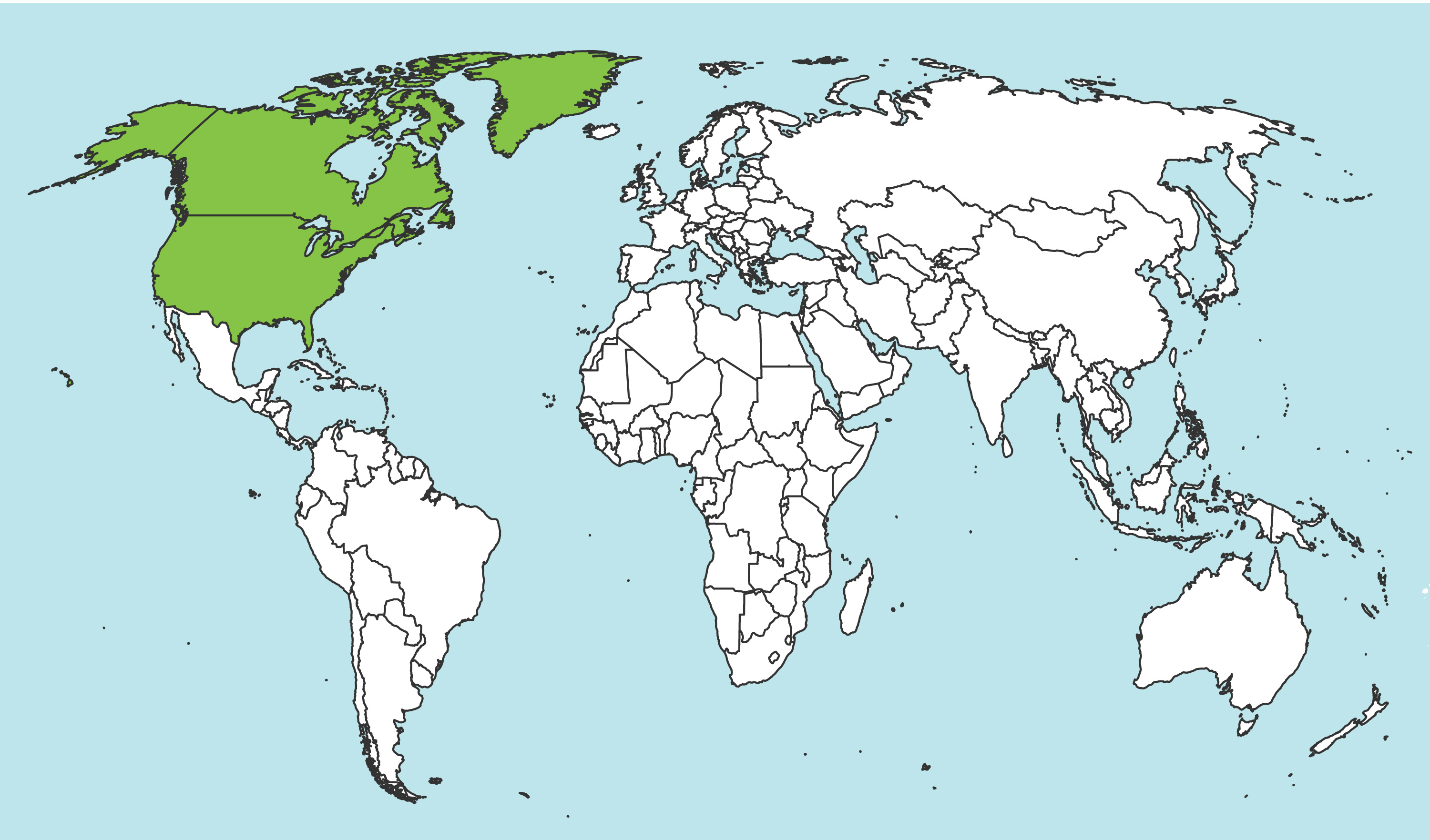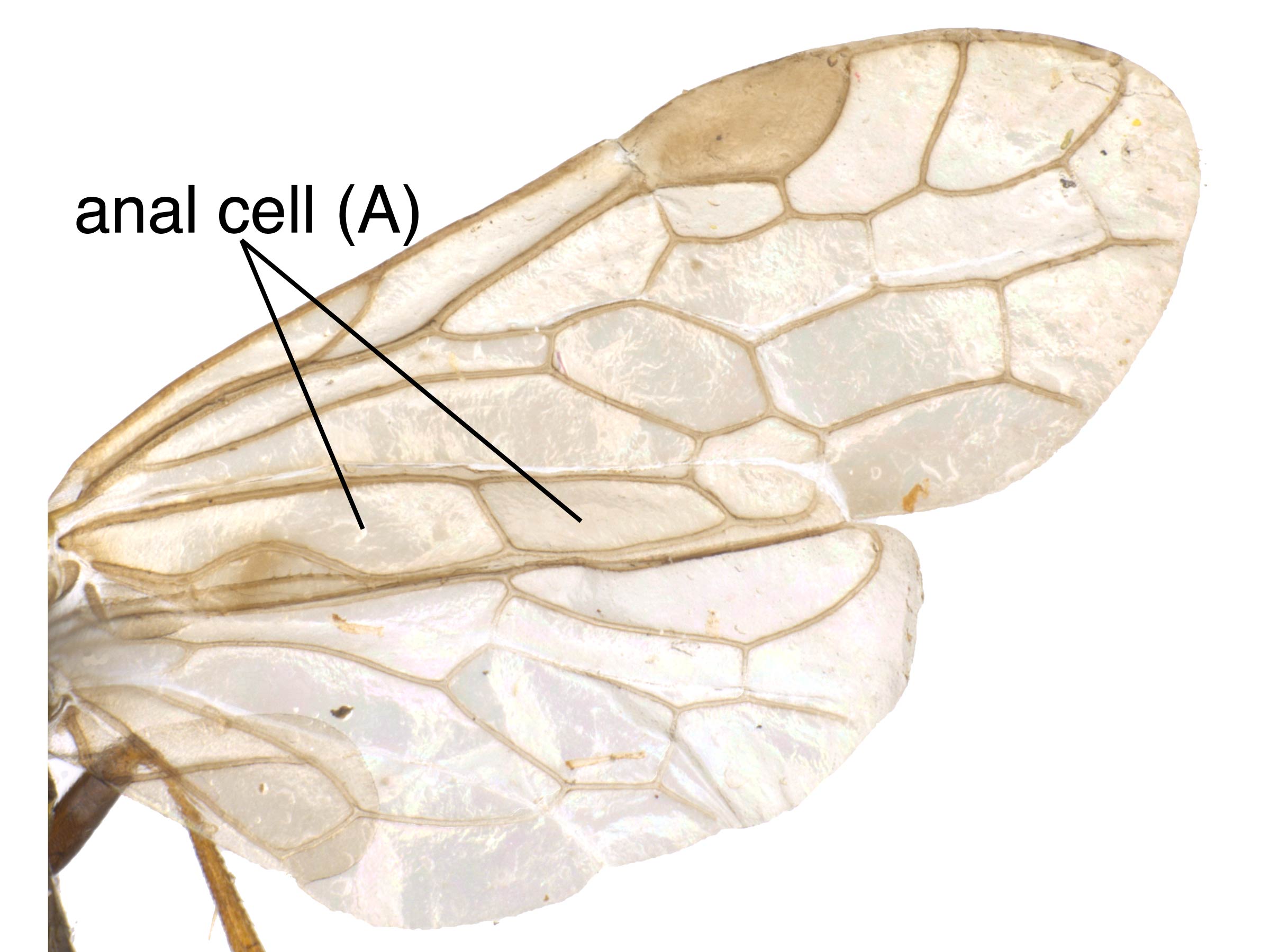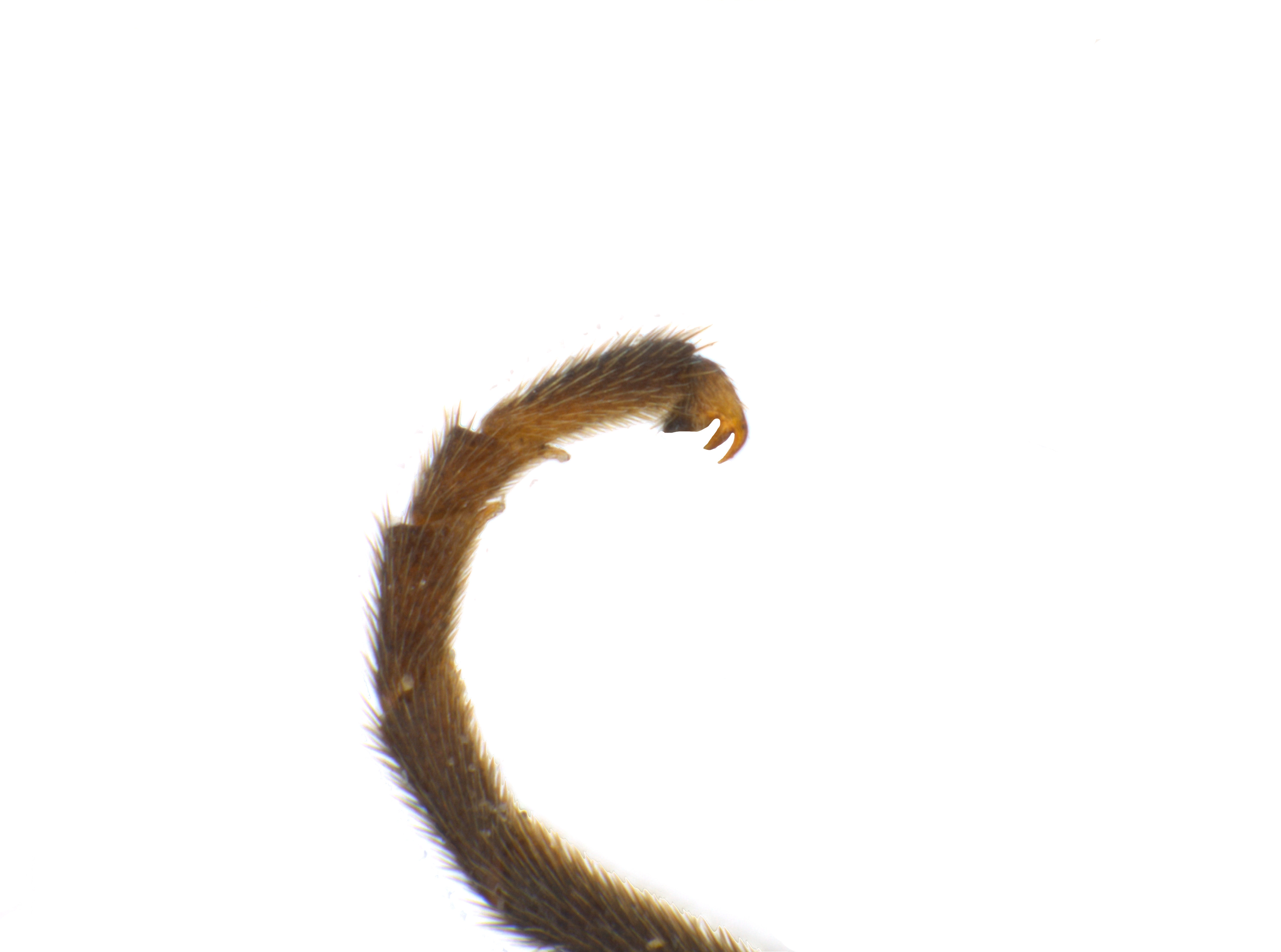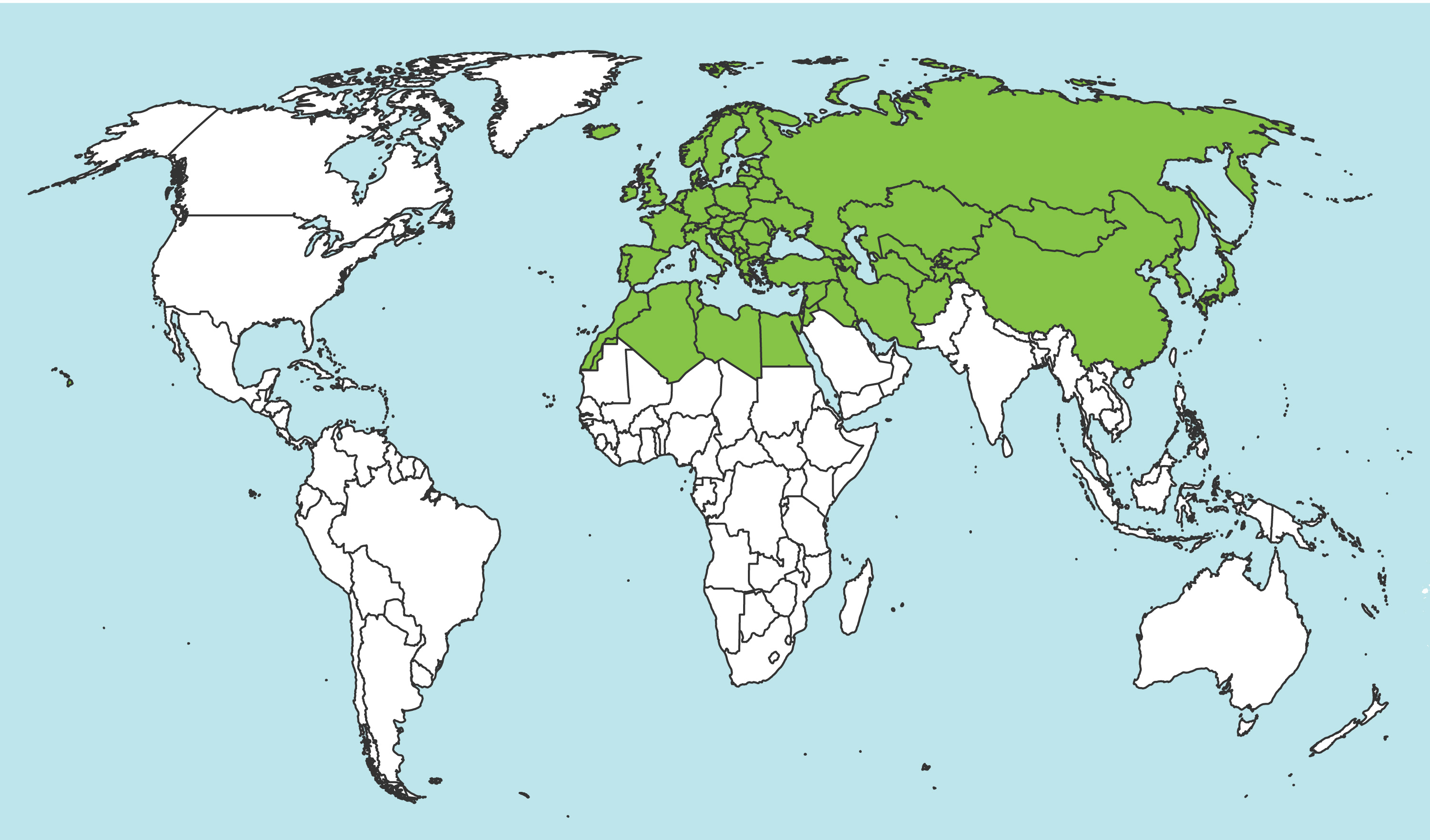Family: Tenthredinidae
Family common name: common sawflies
Subfamily: Heterarthrinae
Tribe: Fenusini
Genus: Fenusella Enslin, 1912
Subgenera: none
The Tenthredinidae are the most species-rich family and are found throughout the world, in all continents but Antarctica. They are known as the “common sawflies.” They can generally be recognized by a cylindrical body and long, segmented antennaeantenna:
the sensory organ emerging from the front of the head, usually between the compound eyes and above the clypeus; includes the flagellum, scape and pedicel
 . Otherwise, they come in a variety of colors, sizes, and forms (Goulet 1992Goulet 1992:
. Otherwise, they come in a variety of colors, sizes, and forms (Goulet 1992Goulet 1992:
Goulet H. 1992. The genera and subgenera of the sawflies of Canada and Alaska: Hymenoptera. Symphyta. The insects and arachnids of Canada. Part 20. Agriculture Canada Publication.).
Sawflies in the Heterarthrinae subfamily are generally small and dark-colored. Many species of this family are economic pests of trees and shrubs and can be characterized by their skeletonizing or leaf-mining larval feeding behaviors. Heterarthrinae adults can be distinguished from those of other subfamilies by wing venationvenation:
the network of veins on a wing
(Smith 1971aSmith 1971a:
Smith DR. 1971a. Nearctic Sawflies. III. Heterarthrinae: Adults and larvae (Hymenoptera: Tenthredinidae). Technical Bulletin, U.S. Department of Agriculture 1420: 1-84.).
Fenusella are generally small, about 3.5–4 mm in length, and most species are black with white markings; F. populifoliella is yellow with black markings (Smith 1971aSmith 1971a:
Smith DR. 1971a. Nearctic Sawflies. III. Heterarthrinae: Adults and larvae (Hymenoptera: Tenthredinidae). Technical Bulletin, U.S. Department of Agriculture 1420: 1-84.). The Fenusini tribe are all leaf miners (Goulet 1992Goulet 1992:
Goulet H. 1992. The genera and subgenera of the sawflies of Canada and Alaska: Hymenoptera. Symphyta. The insects and arachnids of Canada. Part 20. Agriculture Canada Publication.).
There are 11 described extantextant:
in existence; opposite of extinct
species worldwide. Five species occur in North America (Taeger et al. 2010Taeger et al. 2010:
Taeger A, Blank SM, and Liston AD. 2010. World Catalog of Symphyta (Hymenoptera). Zootaxa 2580: 1-1064.).
A key to NearcticNearctic:
describing the region of the Northern Hemisphere that includes North America south through northern Mexico
 species of Fenusella (as Messa) is included in Smith 1971aSmith 1971a:
species of Fenusella (as Messa) is included in Smith 1971aSmith 1971a:
Smith DR. 1971a. Nearctic Sawflies. III. Heterarthrinae: Adults and larvae (Hymenoptera: Tenthredinidae). Technical Bulletin, U.S. Department of Agriculture 1420: 1-84..
Subfamily characters
 M slightly constricted at apexapex:
M slightly constricted at apexapex: vein 2r present (Goulet 1992Goulet 1992:
vein 2r present (Goulet 1992Goulet 1992:Genus characters
 only slightly longer than wide (Smith 1967cSmith 1967c:
only slightly longer than wide (Smith 1967cSmith 1967c: veins 2A and 3A incomplete and curved upwards (Smith 1971aSmith 1971a:
veins 2A and 3A incomplete and curved upwards (Smith 1971aSmith 1971a: anal cellanal cell:
anal cellanal cell: present and petiolatepetiole:
present and petiolatepetiole: cellcell:
cellcell: R1 closed, not open to margin (Smith 1967cSmith 1967c:
R1 closed, not open to margin (Smith 1967cSmith 1967c: with large basalbasal:
with large basalbasal: bifidbifid:
bifidbifid: ; teeth of claw about equal in length (Smith 1971aSmith 1971a:
; teeth of claw about equal in length (Smith 1971aSmith 1971a:Fenusella can be confused with other genera in the subfamily, especially similar genus Metallus. It can be distinguished by the bifidbifid:
divided or forked into two branches or parts
 tarsal claw, antennal pedicelpedicel:
tarsal claw, antennal pedicelpedicel:
the second antennal segment, between the scape and flagellum
 width, and lack of a completely haired mesonotummesonotum:
width, and lack of a completely haired mesonotummesonotum:
the second segment of the dorsum of the thorax
 (Smith 1967cSmith 1967c:
(Smith 1967cSmith 1967c:
Smith DR. 1967c. A review of the subfamily Heterarthrinae in North America (Hymenoptera: Tenthredinidae). Proceedings of the Entomological Society of Washington 69: 277-284., Goulet 1992Goulet 1992:
Goulet H. 1992. The genera and subgenera of the sawflies of Canada and Alaska: Hymenoptera. Symphyta. The insects and arachnids of Canada. Part 20. Agriculture Canada Publication.).
Fenusella wuestneii and F. septentrionalis are leaf-mining pests of willow in Europe (Liston 2007Liston 2007:
Liston AD. 2007. Notes on Palearctic sawflies, with particular reference to the German fauna (Hymenoptera, Symphyta). Nachrichtenblatt der Bayerischen Entomologen 56 (3-4): 82-97.).
Fenusella species in North America feed on Populus nigra (black poplar), Populus fremontii (Fremont cottonwood), Populus canadensis (Carolina poplar), Populus tremuloides (quaking aspen), and Populus balsamifera (balsam poplar) (Smith 1971aSmith 1971a:
Smith DR. 1971a. Nearctic Sawflies. III. Heterarthrinae: Adults and larvae (Hymenoptera: Tenthredinidae). Technical Bulletin, U.S. Department of Agriculture 1420: 1-84., Lotfalizadeh et al. 2017Lotfalizadeh et al. 2017:
Lotfalizadeh H, Shiri T, and Liston AD. 2017. Poplar tree blotch leaf-miner, Fenusella hortulana (Klug) (Hymenoptera: Tenthredinidae), a new pest of Populus in Iran with review of its geographical distribution. Journal of Insect Biodiversity and Systematics 3 (3): 273-279.). Fenusella nana feeds on Betula papyrifera (paper birch) (Digweed et al. 2009Digweed et al. 2009:
Digweed SC, MacQuarrie CJK, Langor DW, Williams DJM, Spence JR, Nystrom KL and Morneau L. 2009. Current status of invasive alien birch-leafmining sawflies (Hymenoptera: Tenthredinidae) in Canada, with keys to species. Canadian Entomologist 141: 201-235.), and F. alaskana feeds on Salix spp. (willow) (Smith 1971aSmith 1971a:
Smith DR. 1971a. Nearctic Sawflies. III. Heterarthrinae: Adults and larvae (Hymenoptera: Tenthredinidae). Technical Bulletin, U.S. Department of Agriculture 1420: 1-84.).
Females oviposit into the edge of the leaf near the main laterallateral:
of or towards the side of the body
veins. After hatching, larvaelarva:
the immature stage of holometabolous insects
 feed on the inner leaf tissue and create blotch mines. They feed for about one month, and then at maturity, the larvaelarva:
feed on the inner leaf tissue and create blotch mines. They feed for about one month, and then at maturity, the larvaelarva:
the immature stage of holometabolous insects
 exit the mines and fall to the soil to build a cellcell:
exit the mines and fall to the soil to build a cellcell:
1. a membranous area of the wing between veins, 2. a small cavity or closed space
 , then burrow and overwinter. Fenusella are univoltineunivoltine:
, then burrow and overwinter. Fenusella are univoltineunivoltine:
describing an insect with a life cycle of one generation per year
(Digweed et al. 2009Digweed et al. 2009:
Digweed SC, MacQuarrie CJK, Langor DW, Williams DJM, Spence JR, Nystrom KL and Morneau L. 2009. Current status of invasive alien birch-leafmining sawflies (Hymenoptera: Tenthredinidae) in Canada, with keys to species. Canadian Entomologist 141: 201-235., Lotfalizadeh et al. 2017Lotfalizadeh et al. 2017:
Lotfalizadeh H, Shiri T, and Liston AD. 2017. Poplar tree blotch leaf-miner, Fenusella hortulana (Klug) (Hymenoptera: Tenthredinidae), a new pest of Populus in Iran with review of its geographical distribution. Journal of Insect Biodiversity and Systematics 3 (3): 273-279.).
Fenusella hortulana is an introduced pest species commonly known as the poplar tree blotch leaf-miner. It is recorded as causing extensive damage on poplar plantations in central and eastern Europe (Georgiev 2006Georgiev 2006:
Georgiev G. 2006. Fenusella hortulana (Hymenoptera: Tenthredinidae) and Shawiana catenator (Hymenoptera: Braconidae) - new species to the fauna of Bulgaria. Acta Zoologica Bulgarica 58 (2): 275-278.), Turkey, and Iran. When present in high populations, F. hortulana can completely defoliatedefoliate:
to elimate a sizeable portion of the foliage of a tree, either by feeding on the leaves or otherwise causing a severe decreae in photosynthetic ability
trees (Lotfalizadeh et al. 2017Lotfalizadeh et al. 2017:
Lotfalizadeh H, Shiri T, and Liston AD. 2017. Poplar tree blotch leaf-miner, Fenusella hortulana (Klug) (Hymenoptera: Tenthredinidae), a new pest of Populus in Iran with review of its geographical distribution. Journal of Insect Biodiversity and Systematics 3 (3): 273-279.). Fenusella nana is another introduced pest known as the early birch leaf edgeminer. The characteristic mines are narrow at the edge of the leaf and expand to a large blotch mine near the center (Digweed et al. 2009Digweed et al. 2009:
Digweed SC, MacQuarrie CJK, Langor DW, Williams DJM, Spence JR, Nystrom KL and Morneau L. 2009. Current status of invasive alien birch-leafmining sawflies (Hymenoptera: Tenthredinidae) in Canada, with keys to species. Canadian Entomologist 141: 201-235.).
World: This genus is known from North America, central Europe, Scandinavia (Liston 2007Liston 2007:
Liston AD. 2007. Notes on Palearctic sawflies, with particular reference to the German fauna (Hymenoptera, Symphyta). Nachrichtenblatt der Bayerischen Entomologen 56 (3-4): 82-97.), and Asia east through Mongolia and Japan (Digweed et al. 2009Digweed et al. 2009:
Digweed SC, MacQuarrie CJK, Langor DW, Williams DJM, Spence JR, Nystrom KL and Morneau L. 2009. Current status of invasive alien birch-leafmining sawflies (Hymenoptera: Tenthredinidae) in Canada, with keys to species. Canadian Entomologist 141: 201-235.).
North America: Fenusella occurs throughout the northern United States and southern Canada, extending south into Colorado and California in the west, as far north as Alaska (Smith 1971aSmith 1971a:
Smith DR. 1971a. Nearctic Sawflies. III. Heterarthrinae: Adults and larvae (Hymenoptera: Tenthredinidae). Technical Bulletin, U.S. Department of Agriculture 1420: 1-84.). Fenusella nana is a PalearcticPalearctic:
describing the region of the northern hemisphere that includes Europe, Asia south to the Himalayas and northern Africa
 species that was first collected in North America in New York and Maine in 1966, and is now recorded throughout eastern Canada and in British Columbia and Washington (Digweed et al. 2009Digweed et al. 2009:
species that was first collected in North America in New York and Maine in 1966, and is now recorded throughout eastern Canada and in British Columbia and Washington (Digweed et al. 2009Digweed et al. 2009:
Digweed SC, MacQuarrie CJK, Langor DW, Williams DJM, Spence JR, Nystrom KL and Morneau L. 2009. Current status of invasive alien birch-leafmining sawflies (Hymenoptera: Tenthredinidae) in Canada, with keys to species. Canadian Entomologist 141: 201-235.).
Map data from: GBIF.org (29 October 2019) GBIF Occurrence Download Fenusella
Details about data used for maps can be found here.